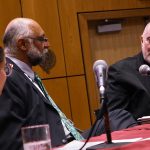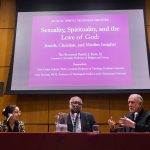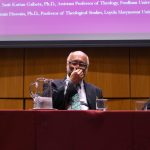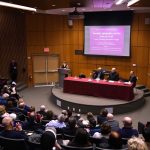


 Three members of different faiths—Judaism, Christianity, and Islam—considered the connection between sexuality and spirituality at the 2019 Spring McGinley Lecture, held on April 9 and 10 at the Lincoln Center and Rose Hill campuses.
Three members of different faiths—Judaism, Christianity, and Islam—considered the connection between sexuality and spirituality at the 2019 Spring McGinley Lecture, held on April 9 and 10 at the Lincoln Center and Rose Hill campuses.
This conversation is more critical than ever, said keynote speaker, Patrick J. Ryan, S.J., the Laurence J. McGinley Professor of Religion and Society. In the wake of the Catholic Church’s sexual abuse scandal, it is important to recognize that sexuality has a sacred meaning in each religion.
“I want to draw your attention to how very human forces, male and female, interact with each other in the imaginative creation of worlds of faith, worlds of spirituality,” Father Ryan said. “How, in particular, do our understandings of human sexuality color how those of us who are Jews, Christians, and Muslims think about God?”
The Bible says that God created Adam, the first human being, as both male and female. (Eve was created from one of Adam’s ribs.) This duality continues to be found in all aspects of life, including marriage, Father Ryan said. It can also be seen in male and female images in the Book of Genesis and the Song of Songs. But one of the most important texts in Judaism, the Zohar, takes a step further and suggests that humanity itself “mirrors and magnifies the Lord God,” he said.
In the same vein, Christian texts show spirituality through sexuality. For example, an autobiography by Saint Teresa of Avila, a 16th-century Christian mystic and writer, portrays the soul and God as passionate lovers, Father Ryan said. She uses graphic imagery to show the angelic piercing of her heart with the spear of God’s love: “When he drew it out, I thought he was drawing them [her entrails]out with it and he left me completely afire with a great love for God.”
The Quran also denotes spirituality through sexual language, he said. The basmalah blessing, which begins every chapter of the Quran but one, uses words that associate “the mercy of God” with a mother’s womb.
“To connect the mercy of God with a feminine physical characteristic is to understand God’s perfection as including all that is most tender in created reality, including the generative and loving characteristics of others,” Father Ryan said.
Although much of the main lecture focused on heterosexual love, respondent Amir Hussain, Ph.D., professor of theological studies at Loyola Marymount University, took a detour from the night’s discourse to reflect on the dangers faced by the LGBTQ community.
“I think of Islamic psychologists from Los Angeles, where I live, who worry about losing their license if they are anything but heteronormative,” he said. “And I wonder how we got to that place where we can hate people for the love that God has put between them.”
For Hussain, it’s a personal issue, as he was an undergraduate at the University of Toronto during the “plague years” of the ’80s, when he said he attended one too many funerals for his friends who died of HIV and AIDS.
“We have to speak out when our gay, lesbian, queer, trans, and bisexual brothers and sisters are threatened,” Hussain said. “We have to lift up the work and voices of LGBTQ scholars and activists, such as Scott Kugle at Emory University, who remind us of the inherent dignity of all of us—regardless of our sexuality.”
The scholar who delivered the Jewish response, Sarit Kattan Gribetz, Ph.D., assistant professor of theology at Fordham, compared two Biblical texts from the Old Testament: Song of Songs and Ezekiel 16. Both stories use the metaphor of a romantic partnership to show God’s relationship with Israel, she said. Only one relationship is healthy though, while the other is marred by manipulation and abuse.
Gribetz’s juxtapositions were often stark. In Song of Songs, the narrator portrays a romantic relationship between a man (God) and a woman (Jerusalem as the spouse of the Lord). Gribetz described the scenes that unfold between the lovers: “A series of kisses, love described as sweeter than wine, fragrant oils, and secluded chambers.”
Ezekiel 16, by contrast, takes a tragic turn. In it, God (a man) saves the people of Jerusalem (a woman) from slavery in Egypt, but is betrayed by the very people he rescues. The text is fraught with dark imagery: an unbathed newborn lying in the blood of her after-birth, nakedness, suffering, and violent threats.
But in these two texts, there is something to be said about humanity, Gribetz said. The stories paint a realistic portrait of the possible intersections among sexuality, spirituality, and love of God—both positive and negative.
“I chose to share with you this evening not only the positive but also the negative, not only the benevolent but also the malevolent, to highlight the empowering dimensions of religious texts, but also to acknowledge those parts of our traditions that are most problematic,” Gribetz said.
“So that we can imagine and construct together models of partnership—human and divine—that are based on mutual love and consent, rather than abuse of power and violation of dignity.”
]]>12th-floor Lounge | E. Gerald Corrigan Conference Center | Lowenstein Center | Lincoln Center Campus
Patrick J. Ryan, S.J., the Laurence J. McGinley Professor of Religion and Society at Fordham, will deliver the annual Spring McGinley Lecture, “Naming God: A Quandary for Jews, Christians and Muslims.”
The lecture will be followed by responses from Rabbi Daniel Polish, Ph.D., of Congregation Shir Chadash in Poughkeepsie and Professor Amir Hussain, Ph.D., of Loyola Marymount University in Los Angeles.
The lecture is free and open to the public. It will be repeated the following day at Rose Hill.
For more information, contact Sister Anne-Marie Kirmse, O.P., Ph.D., GSAS ’89, at 718-817-4746 or[email protected].
For additional information, please visit htto://www.fordham.edu/mcginley_chair.
]]> Scholars of different faiths will convene at Fordham next week on two occasions for the annual Spring McGinley Lecture.
Scholars of different faiths will convene at Fordham next week on two occasions for the annual Spring McGinley Lecture.
Tuesday, April 24
6 p.m.
Pope Auditorium, Lowenstein, Lincoln Center campus
Wednesday, April 25
6 p.m.
Flom Auditorium, William D. Walsh Family Library, Rose Hill campus
Patrick J. Ryan, S.J., the Laurence J. McGinley Professor of Religion and Society, will deliver “The Atheistic Imagination: A Challenge for Jews, Christians, and Muslims” as part of an ongoing interfaith “trialogue” among the three Abrahamic religions. Father Ryan will discuss the works of three prominent fiction authors and what people of Jewish, Christian, and Muslim faiths might draw from the authors’ critiques of their faiths.
Responding to Father Ryan’s talk will be Rabbi Daniel Polish, Ph.D., spiritual leader of Congregation Shir Chadash in Poughkeepsie, N.Y., and Amir Hussain, Ph.D., professor of theological studies at Loyola Marymount University.
The lecture is free and open to the public. For more information, email [email protected].
]]>Patrick J. Ryan, S.J., Fordham’s Laurence J. McGinley Professor of Religion and Society, said Jews, Christians and Muslims should observe how each thinks of Abraham based on each religion’s historical experiences of faith.
Ryan delivered the annual Spring McGinley lecture on April 13 at Fordham’s Lincoln Center campus and again on April 14 on the Rose Hill Campus. “The Faith of Abraham: Bond or Barrier?” continued the “trialogue” between the three Abrahamic religions that he established when he assumed the McGinley Chair in 2009.
Father Ryan began examined how the three religions regard Abraham.
“The most ancient strains in Israelite thought saw in Abraham not just another Mesopotamian Bedouin looking for grazing land and progeny, but the forefather of God’s People and the pioneer of their God-given land,” he said. “Later strains in Jewish thought saw Abraham more as the Jews’ forerunner in faith.”
Father Ryan said the New Testament abandoned the centrality of biological descent from Abraham and Sarah as well as the territoriality of older Israelite thought about Abraham.
“The Pauline writings of the New Testament opened up the possibility of descent from Abraham being extended to all of humanity, Jew and Gentile alike, justified by faith apart from works of the Law,” he said. “The Qur’an, recognizing the monotheism of the People of the Book, looks, however, for something more absolute, a supranational iconoclastic faith in one God who makes demands of all humanity called to surrender itself to God.”
Father Ryan said Muslims and Christians and Jews might live together more fruitfully and more peacefully if they recognize “the polyvalence of Abraham, the polyvalence of great concepts like faith and revelation, community and the path of righteousness.
“Once we have learned how we all creatively reinterpret what may seem to be the same stories, how we all work out varying types of midrash on common themes, we may learn to live together in peace,” he said.
As with the past few McGinley Lectures, Rabbi Daniel Polish, Ph.D., spiritual leader of Congregation of Shir Chadash in Poughkeepsie, N.Y., and Amir Hussain, Ph.D., professor of theological studies at Loyola Marymount in Los Angeles, offered responses to the lecture.
Rabbi Polish said he was in complete agreement with Father Ryan’s take regarding the role of Abraham in the bible and with the mention of land.
“Certainly, the theological role of Abraham, which becomes the central feature of the Christian presentation, cannot be scanted in a Jewish reading of the core text,” Rabbi Polish said. “And as Father Ryan suggests, the parallel midrashic treatment of Abraham took place simultaneously in the Jewish and Christian traditions. The Jewish approach gives greater emphasis than the Bible does to Abraham’s theological role, but not without sufficient appreciation of his paternal role in the genetic sense.”
Though the Jewish tradition does indeed regard Abraham as the father, Rabbi Polish said he could not help but think of how the Jewish calendar excludes any holiday devoted to him.
“It’s been widely recognized that the calendar of any religious tradition is a good indicator of its greatest concern,” he said. “The most attentive study of the Jewish calendar suggests that Abraham doesn’t figure into the Jewish tradition at all. What this implies, I cannot say.”
Is Abraham indeed the genetic father of the Jewish people?
“If so, then Jewish identity must be restricted those who entered into by birth and conversion would thus be impossible,” he said. “Here, significantly, we encounter Abraham again. The conventional format of Hebrew names is ‘So-and-so,’ the son or daughter of ‘So-and-So.’ How could a convert even have a name? The rabbis ordained that converts be known as ‘So-and-So’ the son or daughter of Abraham, and in modern times, of Abraham and Sarah. The act of conversion is thus construed as bringing one directly into the genetic family line of Abraham.”
Hussain delivered a response titled, “Abraham, Sarah, Hagar, Ishmael and Isaac: the Bonds of Family.”
“For Muslims, it’s important to remember the significance of Abraham, who was mentioned by name the second most of any of the prophets in the Qu’ran-69 times,” said Hussain, who also listed the number of times Moses and Isaac are mentioned in the Qu’ran, 137 and 17 times, respectively.
“As a Muslim, I cannot understand the Qu’ranic stories without being familiar with their roles in the bible and oral traditions,” he said. “For me, the appropriate metaphor is triptych-a painting in three panels. Each panel unique, but when viewed together, part of a greater whole.”
Hussain said the reason Mecca is very sacred to Muslims because it is where Abraham and Ishmael, his eldest son and first born, rebuilt the Kaaba, a cube-shaped building in Mecca, Saudi Arabia.
“For Muslims there is a connection to biblical stories,” Hussain said, while listing some of the differences.
“While some may see the difference to all these stories as a barrier, I see them as a bond,” he said. “Perhaps another way to look at is the same characters in different plays each of which needs to be read together-a trilogy.”
]]>